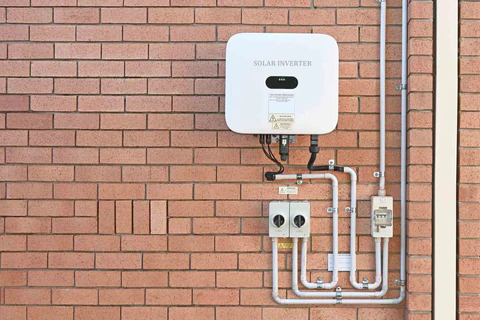How Does a Solar Inverter Work In Real-Time?
 As the number of houses and businesses that take advantage of solar energy in 2025 expands, there is one element common to all these systems the solar inverter. Known as the "brain" of solar setups, it plays a vital role in converting solar energy into usable electricity. In this article, we’ll break down how a solar inverter works in real-time, what happens inside it every second, and why it's essential for modern solar systems.
As the number of houses and businesses that take advantage of solar energy in 2025 expands, there is one element common to all these systems the solar inverter. Known as the "brain" of solar setups, it plays a vital role in converting solar energy into usable electricity. In this article, we’ll break down how a solar inverter works in real-time, what happens inside it every second, and why it's essential for modern solar systems.
Understanding the Character of a Solar Inverter in a Solar Power System
A solar inverter changes direct current from solar panels into alternating current (AC) electricity utilized in homes and businesses. Without it, solar power can't work with standard devices or connect to the national grid. In addition to conversion, the inverter is also a measure of reporting data, energy movement, and protection; therefore, it is the intelligent hub of any solar system.
How a Solar Inverter Works in Real-Time
Solar inverters manage complicated tasks every second to ensure that your energy is moving well. So, nowadays we should examine various operations a solar inverter fulfills in real-time and the way they can be beneficial to your energy system.
1. DC to AC Conversion
The sunlight causes DC electricity to be produced when it comes into contact with your solar panels. But your residence can not accept DC as-is. This DC is instantly converted into AC power using a solar inverter. It takes place immediately and will enable you to produce solar electricity on demand in real-time with zero delays.
2. Real-Time Monitoring and Data Reporting
Solar inverters that are used nowadays have integrated smart technology. They constantly observe the amount of energy generated, the amount of energy consumed, and where. The data can be received via connected apps or web portals so that homeowners can learn about the condition of the system at any time.
3. Grid Interaction and Synchronization
A grid-tied inverter synchronizes your solar power with the utility grid so that you have the proper voltage and frequency. It equalizes the flow of energy as it injects the surplus electricity into the grid and draws electricity out of it as and when required. This coordination is instant, and your home will continue to remain powered at all times.
4. Battery Charging and Management
The battery storage allows the inverter to determine how and at what time energy is stored or utilized in systems with this type of storage. It charges your batteries during the day with any solar power not needed. It releases the energy at night to turn on the lights in your house. This is also because the inverter safeguards your batteries against deep discharge or overcharging and hence increases their life.
5. Protection Mechanisms
The solar inverters are always checking the system to ascertain any variations in the voltage, overload, and short circuiting. In case a problem appears, the inverter will modify or turn off the system to avoid damage. All these real-time military defense capabilities are important to ensure that your system is safe and can be depended on in all circumstances.
What Happens to a Solar Inverter on Cloudy Days?
Solar panels generate electric power even when it's cloudy.. The inverter continues to operate as it did, with whatever DC that exists being converted into AC. Production is less, but the inverter keeps adjusting to cater to the input. It can also pull the stored power in hybrid systems, like batteries, and even switch to a grid supply as and when needed.
How do I Know If My Inverter Is Working accurately?
The majority of inverters include display panels or applications that present the live display of performance statistics. If your inverter is operating normally, you'll see green indicator lights and stable voltage output. In case of an issue such as no output of solar or fault shutdown can code among others, there will be warning lights. The frequent inspections ensure that the system will not stop functioning well.
Can I Use a Solar Inverter Without Solar Panels?
Technically, yes, but it won't serve its purpose. The inverters are created to function in DC input, usually from the solar panels. Without panels, there's no DC electricity to convert, making the inverter inactive. In off-grid layouts, however, batteries can be charged by alternative means, and the batteries are placed in series with inverters.
.jpg)
Why Does My Inverter Make Noise?
Certain inverters hum or buzz in the course of operation. This is good most of the time it is courtesy of internal cooling fans or transformers. But screaming sounds may be a sign that something is wrong, such as overheating, loose connection,s among other internal defects. In such occasions, it's best to consult a solar technician.
What Size Inverter Do I Need for My Solar System?
Your inverter must be the size that you require to match the output capacity of your solar panel array. For example, if your solar panels generate 5kW of power, you'll need an inverter with a similar rating. Smaller-sized inverters may lead to losses of energy, whereas excessively sized inverters may not be effective. The optimal size of inverters is computed by a professional installer depending on the required needs.
Benefits of a Solar Inverter - Unlock the full potential of your solar system!
You need solar inverters to make sure your solar system performs to the best of its ability. And these are the top advantages that they can give your business or home:
1. Efficient Energy Conversion
Solar inverters guarantee that the DC energy that your panels generate becomes useful AC power with little energy that is lost in the process.
2. Smart Monitoring & Control
They can also bring real-time information on the functioning of systems, of energy generation and consumption trends and patterns, via mobile apps or web dashboards.
3. Enhanced System Protection
Inverters contain internal safety switches that sense electrical faults and de-energize the system to help avoid equipment damage.
4. Grid Compatibility
Inverters coordinate the interaction with the utility grid and allow such functions as net metering and load balancing.
5. Battery Storage Support
In a hybrid system, the inverter is charged and discharged by controlling the inverter, which helps in tapping the maximum of stored solar energy during the night or when the power goes out.
FAQ’s
Q1. So what is this solar inverter about? Why does a solar power system need this?
The use of a solar inverter is required since it cleans up the DC electricity created by solar panels into the AC electricity employed by homes and appliances.
Q2. Is a solar system possible without an inverter?
No, a solar system without an inverter will not work well because the DC power that the panels are trying to deliver would not be able to offer compatibility to the ordinary home electrical system.
Q3. What then is the difference between microinverters and string inverters?
String inverters regulate power on multiple panels at a time, but microinverters are installed on individual panels, which helps them execute better in shady light areas or where light is less evenly provided.
Q4. What is the solar inverter's lifespan?
Solar inverters have a 10-15-year lifespan, but very good inverters with good maintenance have a still longer lifespan.
Q5. So what will be the case when the inverter fails?
Any failure in the inverter means that your solar system will not be able to convert energy and will cease to distribute usable electricity. When it occurs, monitoring systems normally tell you about it.
Conclusion
The reason to learn how a solar inverter works in real time is that there is greater value to gain from your solar energy system. It has the capacity to switch between DC and AC power, storage, energy control, and safeguard of system errors in a short time. Whether you're using solar or planning to switch, knowing how your inverter powers your home highlights its vital importance.





